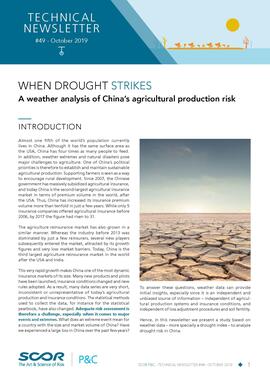- FR
- EN
When drought strikes
A weather analysis of China’s agricultural production risk
October 30, 2019

Almost one fifth of the world’s population currently lives in China. Although it has the same surface area as the USA, China has four times as many people to feed. In addition, weather extremes and natural disasters pose major challenges to agriculture. One of China’s political priorities is therefore to establish and maintain sustainable agricultural production. Supporting farmers is seen as a way to encourage rural development. Since 2007, the Chinese government has massively subsidized agricultural insurance, and today China is the second-largest agricultural insurance market in terms of premium volume in the world, after the USA. Thus, China has increased its insurance premium volume more than tenfold in just a few years. While only 5 insurance companies offered agricultural insurance before 2006, by 2017 the figure had risen to 31.
The agriculture reinsurance market has also grown in a similar manner. Whereas the industry before 2013 was dominated by just a few reinsurers, several new players subsequently entered the market, attracted by its growth figures and very low market barriers. Today, China is the third largest agriculture reinsurance market in the world after the USA and India.
This very rapid growth makes China one of the most dynamic insurance markets of its size. Many new products and pilots have been launched, insurance conditions changed and new rules adopted. As a result, many data series are very short, inconsistent or unrepresentative of today’s agricultural production and insurance conditions. The statistical methods used to collect the data, for instance for the statistical yearbook, have also changed. Adequate risk assessment is therefore a challenge, especially when it comes to major events and extremes. What does an extreme event mean for a country with the size and market volume of China? Have we experienced a large loss in China over the past few years?
To answer these questions, weather data can provide initial insights, especially since it is an independent and unbiased source of information – independent of agricul-tural production systems and insurance conditions, and independent of loss adjustment procedures and soil fertility.
Hence, in this newsletter we present a study based on weather data – more specially a drought index – to analyze drought risk in China.
Authors


